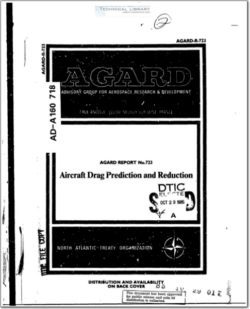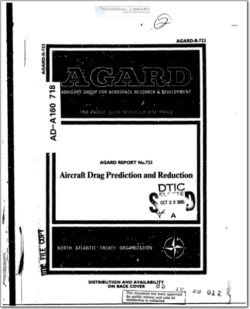AGARD-R-723

- Version
- 255 Downloads
- 16.39 MB File Size
- 1 File Count
- April 28, 2016 Create Date
- April 28, 2016 Last Updated
Aircraft Drag Prediction and Reduction

This paper presents a review of the current techniques of aircraft viscous drag reiuction and sane of the more recent
developnents that have taken place in this technology. The various sources and relative contributions of aircraft drag
are described including skin friction drag, pressure drag, interference drag and lift induced drag. In the discussion,
anphasis is given to the physical processes that lead to these drag contributions, followed by a discussion of
methods of reducing the mpacl. of these drag sources. Finally sane brief discussion is presented to show how
innovative and optimized aircraft configurations can lead to drag benefits.
Since the early seventies and the subsequent trend in world fuel prices (Figure 1), aircraft drag reduction technology
has become of prime importance to military and civilian operators. For example, a 101 drag reduction on a large
military transport aircraft is estimated to have the potential to save up to 13 million gallons of fuel per aircraft
over the lifetime of the aircraft. Considering also that US domestic operators spent a staggering 2.1 billion dollars
on fuel in 1976 alone, it is clear that enormous benefits are to be derived from drag reduction technology.
Additionally, with the very high cost of aquisition of nu aircraft, existing fleet lifetimes are being extended and
derivative design are now coming on to the marketplace. Thus, retrofittable drag reduction technologies are
critically isportant.
The aerodynamic forces aperienced at the surface of an aircraft may be either tangential to the surface or normal to
the surface and both will contribute to the total drag on the body. The interrelation and develowent of these forces
is shown in Figure 2. The only tangential force that is present is the viscous skin friction due to the developaent of
boundary layers over the surfaces. The development of the normsl forces, i.e. pressures normal to the surface, is more
complex and, as Figure 2 shows, these can arise from a saber of contributions. Firstly, there is the pressure field
modification due to the displacement thickness of the boundary layers and possible formation of regions of separat-
ion (and which, with the skin friction, constitutes the profile drag). Next, there are pressure forces that arise from
the formation of vortices in the wake and which may further modify the flow aromas! the body. This is termed vortex
drag. If compressibility effects are nresent, then there are additional pressure forces due to the messibility
effects and the presence of waves in the flow.
The non-zero integrated strenise component of these pressure forces constitutes the pressure drag on the aircraft.
Because lifting conditions are present, there is a stm cmponent of the lift-dependent vortex drag which in
conjunction with a filler mint of lift~dependent profile drag gives rise to the so-called induced drag.
| File | Action |
|---|---|
| AGARD-R-723 Aircraft Drag Prediction and Reduction.pdf | Download |
Comment On This Post